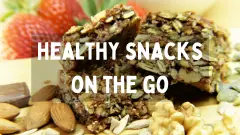Even if you are a healthy weight, it’s still important to have a healthy diet. A bad diet will catch up with you eventually and cause health problems. Apart from weight control, the benefits of a healthy diet include better short-term and long-term health, healthier skin and hair, more energy and stronger bones. This post goes through the basics of a healthy diet and includes a healthy food list, together with a shopping list, to help you shop for the right foods.
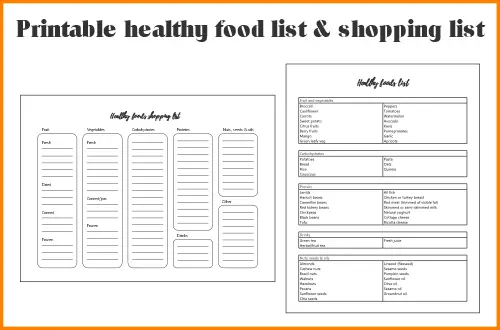
Healthy food and weight control
Most people who eat a balanced, healthy diet aren’t overweight. On the other hand, diets that are full of highly processed carbohydrates (especially added sugar) lead to rapid weight gain. Crash and fad dieting sometimes result in short-term weight loss, but they aren’t usually successful in the long term. This is because when people end the diet they go back to their old eating habits and put the weight back on. Making permanent healthy changes is the only long-term solution to being a healthy weight.
The basic guidelines on a healthy diet

You’ll see all sorts of conflicting advice about how to lose weight, a lot of which is marketing for weight loss products. However, the advice from all the official health agencies and charities, which is based on years of research, is fairly consistent. Below is a summary of what they advise on the main food groups.
Complex carbohydrates (also called starches)
This food group includes bread, rice, pasta, potatoes, couscous, porridge oats and any other grain based foods. All carbohydrates are made up of units of glucose. The difference between simple carbs and complex carbs whether the food is made up of long strings of glucose (complex) or short strings (simple, also known as sugars).
Because complex carbs are made up of long glucose strings, they take longer to be broken down and so provide a steady supply of glucose for our bodies to use as energy. Simple carbs are quickly converted to glucose and cause blood sugar spikes.
The advice is that the largest proportion of our calories should come from complex carbohydrates. This advice conflicts with the popularity of carb-free diets of course. It’s true that carb-free diets can be successful for weight control, but nutritionists advise against them. Our bodies need glucose for energy and will convert proteins and fats to glucose if there is no glucose in the diet. This can cause a range of unpleasant side effects and is thought to be bad for long term health. You should have a large helping of complex carbs with each meal, preferably wholegrain varieties (see below).
Healthy carbs
- Potatoes
- Sweet potatoes
- Bread (brown)
- Rice (brown)
- Couscous (brown)
- Pasta (brown)
- Oats
- Quinoa
Simple carbohydrates (sugars)
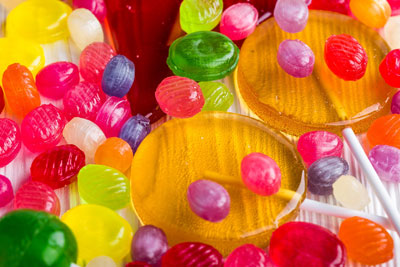
This group includes fruit sugar, milk sugar (lactose) and all processed sugar. As mentioned above, they are called simple carbohydrates because they have a very short molecular chain. This means that they are broken down and digested quickly, causing blood sugar to rise. The body’s response is to produce insulin and store any sugar that isn’t needed as fat. We therefore need to keep our intake of simple carbs low. Only about 10% of our calories should come from them.
Healthy sources of simple carbs
- Fruit & juice
- Dairy products
- Honey
Protein
We need Protein for building new cells. Our exact requirement depends on body weight, but as a rough guide, someone with normal levels of body fat who weighs 60kg would need about 45g of protein a day.
A wide range of foods contain protein. Plant sources of protein usually have no saturated (bad) fat, whereas meat and dairy sources can be quite high in saturated fat. Nuts and oily fish are high in unsaturated (good) fats. All of the follwoing foods are good sources of protein, as well as the nuts and seeds listed below:
- Lentils
- Haricot beans
- Cannellini beans
- Red kidney beans
- Chickpeas
- Black beans
- Tofu
- All fish
- Chicken or turkey breast
- Red meat (trimmed of visible fat)
- Skimmed or semi-skimmed milk
- Natural yoghurt
- Cottage cheese
- Ricotta cheese
Fat
Fat contains over double the calories per gram that protein and carbs contain, so we need to limit our intake. Extensive research shows saturated fat to be damaging to the heart and circulatory system so intake of this should be as low as possible. Most of the saturated fat in our diets comes from meat and dairy products. The recommendation is that around 30% of our calories should come from fat, but that a maximum 10% should be from saturated fats. For the average woman, this would be around 70-80g total fat intake per day, with a maximum of around 25g of saturated fat. Sources of unsaturated fat include nuts, seeds, oils and oily fish.
Fruit and vegetables
The recommendation is that we eat at least 5 x 80g portions per day of a variety of fruit and vegetables. These can be fresh, frozen or canned. Dried fruits count too – the portion size for these would be 30g. A glass of juice can count as one portion a day. Beans and pulses can also be one of your portions. However, they are not as good a source of nutrients as fruit and vegetables, so should only count as one of your portions even if you have more than one serving.
All fruits and vegetables are good and we should aim to eat a wide variety. Some are particularly high in beneficial chemicals and these are known as “superfoods”. The list below is some of the most common superfoods.
- Broccoli
- Cauliflower
- Carrots
- Sweet potato
- Citrus fruits
- Berry fruits
- Mango
- Green leafy veg
- Peppers
- Tomatoes
- Watermelon
- Avocado
- Kiwis
- Pomegranates
- Garlic
- Apricots
Nuts, seeds and oils
While we need to be careful of eating too much fat, it is an essential part of our diet. As much of our fat intake as possible should be from unsaturated sources. Unsaturated fat helps to keep cholesterol low, while saturated fat raises it. Nuts and seeds have lots of valuable nutrients and fibre, as well as being sources of unsaturated fat. Oils don’t have fibre, but do have some nutrients and are a better choice than animal fats for cooking. Nuts and seeds are also healthy protein sources. Add some of the following to your diet:
- Almonds
- Cashew nuts
- Brazil nuts
- Walnuts
- Hazelnuts
- Pecans
- Sunflower seeds
- Chia seeds
- Linseed (flaxseed)
- Sesame seeds
- Pumpkin seeds
- Sunflower oil
- Olive oil
- Sesame oil
- Groundnut oil
Drinks
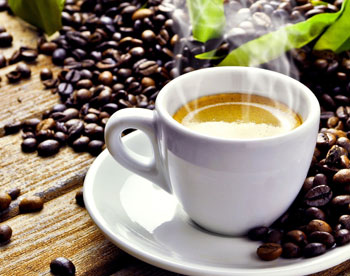
Drinks are often a source of sugar that people don’t even think about. Tea and coffee with added sugar, squash, fizzy drinks and hot chocolate should all be avoided or kept to a minimum. We should drink plenty of water (ideally not bottled, because of the problem with plastic waste). Juice in moderation is good, but it’s also a source of natural fruit sugar so large quantities aren’t advisable. Tea and coffee without added sugar are OK in moderation. Green tea and fruit or herbal teas are a healthy option.
Healthy drinks to add to your shopping list:
- Green tea
- Herbal/fruit tea
- Fresh juice
How can you make sure you’re having the right amount of everything?
Unfortunately, this isn’t straightforward, because most foods are a mix of different nutrients, fibre and water. For example, if you look at your pasta packaging, you’ll see that it’s about 75% carb. So if you want 50g of carb, you have to work out how much pasta will give you that. Then you also need to consider that the protein in the pasta (around 15% of weight) counts towards your protein intake.
To make it simple, the Eatwell Plate was developed. The idea is that as long as you stick to roughly these proportions of food, you’ll be doing OK:
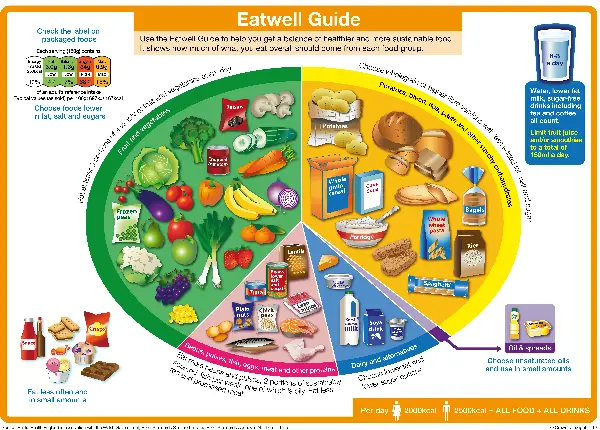
Healthy food list and shopping lists
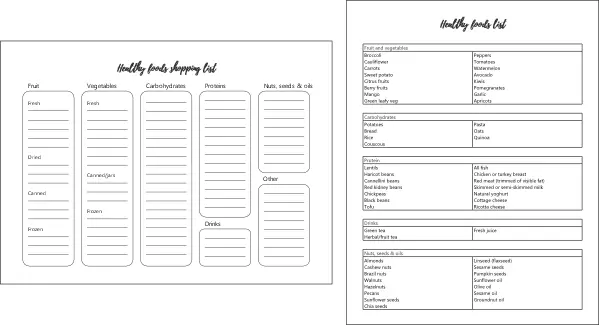
You can download these two lists to help you plan a healthier diet. The healthy food list contains all the suggested healthy foods in this post and the shopping list is blank for you to add your choice of healthy foods. Sign up for My Fitness Planner updates by entering your e-mail address below and you’ll get a download link e-mailed to you.
After you sign up, you’ll get 2 e-mails, one will have a link to your printable download and the other will be a welcome e-mail.
If the e-mails haven’t turned up within a few minutes, please check your junk folder, as some service providers have very strict filters.
After you sign up, you’ll get 3 e-mails:
The first will ask you for a one-click confirmation of your subscription
Once you’ve confirmed, you’ll get a second e-mail with a link to your download and a separate welcome e-mail

